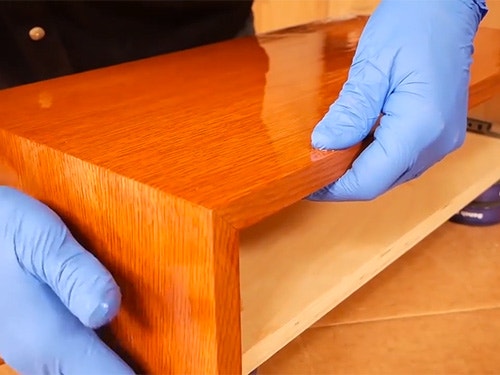How To Apply Oil Stain Finish To Open Grain Hardwood
How to apply this finish:
1. Sand the project up through the grits until at least 220-grit. It is a good idea to sand pieces that will be hard to reach before assembly.
2. Wipe the project with mineral spirits to check for glue splotches.
3. Apply a good quality Oil Pigment Stain, dry 24 hours (Oil stains are easier to apply).
4. Use a good quality urethane top coat finish. Flood it on, let it sit and wipe it off. Let towels dry flat and dispose of properly!
5. If you have any nail holes, cracks or defects in the wood, fill them now with a wood filler putty that matches the color of the stained wood (sand smooth).
6. Apply at least two more coats urethane top coat finish.
7. Optional: After the finish has cured for 72 hours, apply a coat of high-quality paste wax and then polish it off.
Supply Checklist:
Video: How To Apply Oil Stain Finish To Open Grain Hardwood
Rob Johnstone: Today I'm going to demonstrate how to apply an oil stain to an open-grained hardwood, and then follow that up with a wipe-on polyurethane finish. Now, open-grained hardwoods are things like white oak, ash, and red oak. They all have open cell structure which works really great with an oil stain. Now, the key to any finishing project is proper surface preparation. In most cases, that means sanding. Because it's going to be an oil stain, I recommend starting out at 80 grit and working up without skipping any levels. Next 100 grit, 120 grit, 150 grit, and then stopping at 180 grit.
Move the sander slowly across the surface, about one inch per second. Most people move the sander far too fast. Neither moving the sander faster nor skipping grits will save you time on this task. Remember, as you advance to each finer grit, your goal is simply to remove the last grit's scratches or sanding marks. There's one more step that we need to do before we can apply the oil stain and that's to look for any glue spots that may have survived the sanding process. We do that with mineral spirits.
The glue spot will keep the stain from being absorbed by the wood fibers. If you find a glue spot with mineral spirits, you're going to need to sand it away. Grab your sandpaper, starting back at 80 grit and sand all the way up to 180 grit again. With that done, it's time to add some color. To apply the stain, I use a clean white cloth. It's a time-honored method and it is very easy to do. Wipe on an even coat of the stain with a circular motion. Then, wipe off the excess with blue shop towels. Check the piece carefully to be sure you have not missed a spot and let it cure overnight. To dispose of these towels that are saturated with oil, you need to flatten them out, lay them out and let them dry.
Once they do dry completely overnight or maybe even longer, they're landfill safe. You don't want to leave something like this wadded up or it could spontaneously combust. Now it's time to apply the first coat of the wipe on polyurethane. You might notice that this armor seal doesn't say wipe on anywhere but the truth is almost any clear finish can be wiped on successfully. I like to use these synthetic scratchy pads in a small version, you can dip it in and it allows me to put a nice thin coat into all the corners, and then, I follow it up, I wipe it off with some blue shop towels. Now let's get a nice even coat of the poly all over the whole piece. Now we use these blue shop towels to wipe it off.
You're still leaving a nice thin coat of polyurethane down but the great thing is, this is what makes it a no-fail finish because no drips, no splotches. Wiped the last little bit off and as with any oil-based finish or stain, it's important to dispose of the towels as we described previously. With your stain coat on and your first coat of wiped-on poly dry, now's the time to fill any nail holes or cracks with putty or a wood filler. The advantage is now you have the proper color to match. You can do that either if you find a putty that matches perfectly or you can always mix two different colors together to get a good match and that's what we did here in this case.
Remember, usually darker is better than lighter. Wipe on at least three or four coats of this poly allowing it to cure completely between and if you see dust nibs or anything that's not super smooth, you just go ahead sand it down with like a 300 grit sandpaper, something very fine and you'll have a great, great finish.
That's it, a no-fail finish of stain followed by wipe-on polyurethane on open-grained hardwood. I have one final tip for you. After your last coat of polyurethane has cured for at least 72 hours. Get out your good quality paste wax, rub it on, polish it off and leave a nice low luster and it will feel so great.
Keep the inspiration coming!
Subscribe to our newsletter for more woodworking tips and tricks







